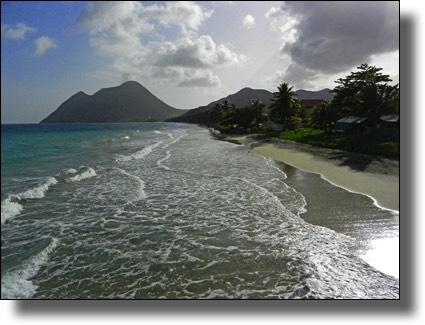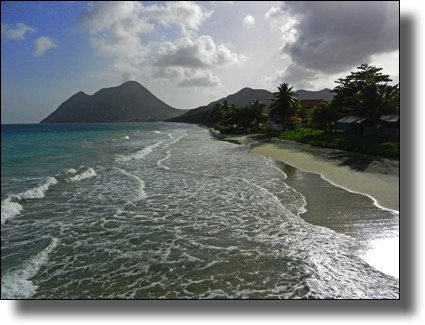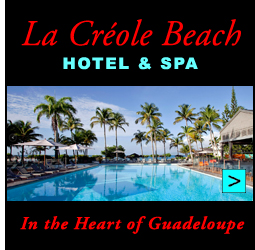Martinique Tours, Sightseeing, Excursions
There is an extraordinary range of sightseeing opportunities on this large, diverse and fascinating island. Complimentary Martinique maps, brochures and information bulletins are available at the Tourist 0ffice, where an English-speaking staff is very helpful with suggestions about what to see and do.

The little publication, Choubouloute, includes listings of happenings on the island. Sightseeing tours are offered by taxi or motor coach. Additional information can be found at the Tourist Office and at hotel desks.
MARTINIQUE'S CAPITAL CITY
Fort-de-France, the capital, is wonderful to explore on foot. Among the sightseeing attractions is the city's architectural masterpiece, the Bibliothèque Schoelcher, or Schoelcher Library, a Romanesque-Byzantine gem built over 100 years ago for the Paris Exposition of 1889, then dismantled and shipped to Martinique mosaic by mosaic. Named for Victor Schoelcher, the French abolitionist whose work helped end slavery on the island in 1848, it sits just off La Savane, the central park.
La Savane's gardens make for pleasant strolling and picture-taking, and boast two impressive statues: one of Pierre Belain d'Esnambuc, the French nobleman who claimed the island for France in 1635, the other of Marie Josephe Rose Tascher de la Pagerie, who was born in Trois Ilets across the bay, and made history as Napoléon's Empress Joséphine.
The capital's narrow balconied streets, lined with shops and restaurants, all lead to a pleasant discoveries, including the Cathedral of Saint-Louis, the Palais de Justice with its statue of Victor Schoelcher, the Musée Départemental with archeological finds from prehistoric Martinique and the Rivière Madame with its busy fish markets. Excellent, reasonably-priced guided walking tours of Fort-de-France are available for a fee.
NORTHERN MARTINIQUE
The classic tour of Martinique travels north along the Caribbean coast to St. Pierre, know as the ''Paris of the West Indies" until 1902, when Mont Pelée Volcano erupted and turned it into a New World Pompeii. A museum on the spot vividly portrays the tragedy. In 1990, St. Pierre was designated a Ville d'Art et d'Histoire. The drive from Fort-de-France takes less than an hour, but stops along the way are recommended, including the fishing villages of Case-Pilote and Bellefontaine, as well as Carbet, where Columbus landed in 1502 and where Gauguin lived and painted in 1887. The Gauguin Museum is well worth a visit.
Located between Carbet and St. Pierre and great for adults and kids, Habitation Latouche, an estate dating from 1643, is the island’s new zoo, featuring animals from the four corners of the world.
Inland is Morne Rouge, a pretty town with a cool climate, and site of MacIntosh Plantation, a renowned cultivator of Martinique's best-known flower, the anthurium. Nearby is La Trace, a dazzling route through the rain forest. This mountainous northern half of the island is also lush with banana and pineapple plantations, avocado groves, cane fields, and several lovely old island inns such as Habitation Lagrange.
Other noteworthy communities in the north include: Le Precheur, the last village along the northern Caribbean coast, known for hot springs of volcanic origin and the Tomb of the Carib Indians. Ajoupa Bouillon is an enchanting flower-lined town with a nature trail called Les Ombrages and, nearby, the Gorges de la Falaise, mini-canyons along the Falaise River, lead to a waterfall. Grand' Rivière is a picturesque fishing village constantly braving the fierce Atlantic Ocean.
Also in the north, near Trinité, the beautiful Caravelle Peninsula houses the ruins of the Chateau Dubuc, a spot as fascinating as some of its family members: Louis-Fransois Dubuc, the man instrumental in preventing the spread of the French Revolution to Martinique, and Aimee Dubuc de Rivery who, like Joséphine, was destined for history. Returning home to Martinique after schooling in Europe, she was captured by pirates, sold into slavery, then given as a present to the Sultan of Constantinople. Aimée became Sultana Vallde, mother of Sultan Mahmoud II.
As rich as the island's history is the island's soil. Rum distilleries abound throughout Martinique and all of them welcome visitors for a sampling of their product. The St. James Distillery at Sainte-Marie in the north operates the Musée du Rhum. (Nearby is Morne des Esses, a straw-weaving center.) The charming Rhum Clement Domaine Acajou in Le François on the east coast, site of the March 1991 Summit Meeting of Presidents Bush and Mitterrand, recently added a fine contemporary museum. The Fonds Saint Jacques, a historically important 17th-century sugar estate in the north, attracts visitors with its Musée Père Labat, and lastly, further south, just outside Trois Ilets, is the Maison de la Canne, a modern museum devoted to sugar and rum.
Martinique is called the "Isle of Flowers," and stops at some of its floral gardens are rewarding experiences. Don't miss the beautiful Jardin de Balata on the Route de La Trace in the suburbs north of the capital. A short drive from here is the Sacre Coeur de Balata, a scaled-down replica of the famed Sacre Coeur basilica which dominates Montmartre in Paris.
SOUTHERN MARTINIQUE
Southern Martinique sightseeing attractions include the historic offshore landmark, H.M.S. Diamond Rock, a sort of Caribbean Gibraltar rising 183m (600 ft) from the sea. Le Roche de Diamant was actually used by the British as a sloop of war in an 1804 sea battle. There is also Le Marin, with a well-equipped marina, as well as an ancient Jesuit-style church dating to 1766.
Near Diamant, don't miss the Anse Caffard Mémorial. In 1830, a ship capsized in rough weather nearby. Of the 46 bodies recovered, all but four were Africans destined for the illicit slave trade. The tragic event is honored in a moving memorial created by local artist Laurent Valère featuring 15 massive concrete statues.
The coves, peninsulas and white sand beaches around Salnte-Anne, most notably the Plage des Salines and Cap Chevalier, are considered among the most beautiful in the Caribbean.
Near Trois Ilets is the Empress Josephine's birthplace, La Pagerie, which has a museum chock-full of her mementos; nearby is the Parc des Floralies, a peaceful and pretty botanical park.
Likewise of note in the vicinity are the Potters Center and the 18-hole Golf de l'lmpératrice, a Robert Trent Jones course.
Opportunities to tour southern Martinique rum distilleries are available at La Mauny Distillerie at Riviere Pilote, and at the Trois-Rivieres Estate near Ste. Luce.
Sightseeing the island's underwater world is can be accomplished by semi-submersible craft. One is based at Le Marin and another at the Marina Pointe-du-Bout. Tours make for unusual water excursions and take approximately one hour.
MARTINIQUE'S CAPITAL CITY
Fort-de-France, the capital, is wonderful to explore on foot. Among the sightseeing attractions is the city's architectural masterpiece, the Bibliothèque Schoelcher, or Schoelcher Library, a Romanesque-Byzantine gem built over 100 years ago for the Paris Exposition of 1889, then dismantled and shipped to Martinique mosaic by mosaic. Named for Victor Schoelcher, the French abolitionist whose work helped end slavery on the island in 1848, it sits just off La Savane, the central park.
La Savane's gardens make for pleasant strolling and picture-taking, and boast two impressive statues: one of Pierre Belain d'Esnambuc, the French nobleman who claimed the island for France in 1635, the other of Marie Josephe Rose Tascher de la Pagerie, who was born in Trois Ilets across the bay, and made history as Napoléon's Empress Joséphine.
The capital's narrow balconied streets, lined with shops and restaurants, all lead to a pleasant discoveries, including the Cathedral of Saint-Louis, the Palais de Justice with its statue of Victor Schoelcher, the Musée Départemental with archeological finds from prehistoric Martinique and the Rivière Madame with its busy fish markets. Excellent, reasonably-priced guided walking tours of Fort-de-France are available for a fee.
NORTHERN MARTINIQUE
The classic tour of Martinique travels north along the Caribbean coast to St. Pierre, know as the ''Paris of the West Indies" until 1902, when Mont Pelée Volcano erupted and turned it into a New World Pompeii. A museum on the spot vividly portrays the tragedy. In 1990, St. Pierre was designated a Ville d'Art et d'Histoire. The drive from Fort-de-France takes less than an hour, but stops along the way are recommended, including the fishing villages of Case-Pilote and Bellefontaine, as well as Carbet, where Columbus landed in 1502 and where Gauguin lived and painted in 1887. The Gauguin Museum is well worth a visit.
Located between Carbet and St. Pierre and great for adults and kids, Habitation Latouche, an estate dating from 1643, is the island’s new zoo, featuring animals from the four corners of the world.
Inland is Morne Rouge, a pretty town with a cool climate, and site of MacIntosh Plantation, a renowned cultivator of Martinique's best-known flower, the anthurium. Nearby is La Trace, a dazzling route through the rain forest. This mountainous northern half of the island is also lush with banana and pineapple plantations, avocado groves, cane fields, and several lovely old island inns such as Habitation Lagrange.
Other noteworthy communities in the north include: Le Precheur, the last village along the northern Caribbean coast, known for hot springs of volcanic origin and the Tomb of the Carib Indians. Ajoupa Bouillon is an enchanting flower-lined town with a nature trail called Les Ombrages and, nearby, the Gorges de la Falaise, mini-canyons along the Falaise River, lead to a waterfall. Grand' Rivière is a picturesque fishing village constantly braving the fierce Atlantic Ocean.
Also in the north, near Trinité, the beautiful Caravelle Peninsula houses the ruins of the Chateau Dubuc, a spot as fascinating as some of its family members: Louis-Fransois Dubuc, the man instrumental in preventing the spread of the French Revolution to Martinique, and Aimee Dubuc de Rivery who, like Joséphine, was destined for history. Returning home to Martinique after schooling in Europe, she was captured by pirates, sold into slavery, then given as a present to the Sultan of Constantinople. Aimée became Sultana Vallde, mother of Sultan Mahmoud II.
As rich as the island's history is the island's soil. Rum distilleries abound throughout Martinique and all of them welcome visitors for a sampling of their product. The St. James Distillery at Sainte-Marie in the north operates the Musée du Rhum. (Nearby is Morne des Esses, a straw-weaving center.) The charming Rhum Clement Domaine Acajou in Le François on the east coast, site of the March 1991 Summit Meeting of Presidents Bush and Mitterrand, recently added a fine contemporary museum. The Fonds Saint Jacques, a historically important 17th-century sugar estate in the north, attracts visitors with its Musée Père Labat, and lastly, further south, just outside Trois Ilets, is the Maison de la Canne, a modern museum devoted to sugar and rum.
Martinique is called the "Isle of Flowers," and stops at some of its floral gardens are rewarding experiences. Don't miss the beautiful Jardin de Balata on the Route de La Trace in the suburbs north of the capital. A short drive from here is the Sacre Coeur de Balata, a scaled-down replica of the famed Sacre Coeur basilica which dominates Montmartre in Paris.
SOUTHERN MARTINIQUE
Southern Martinique sightseeing attractions include the historic offshore landmark, H.M.S. Diamond Rock, a sort of Caribbean Gibraltar rising 183m (600 ft) from the sea. Le Roche de Diamant was actually used by the British as a sloop of war in an 1804 sea battle. There is also Le Marin, with a well-equipped marina, as well as an ancient Jesuit-style church dating to 1766.
Near Diamant, don't miss the Anse Caffard Mémorial. In 1830, a ship capsized in rough weather nearby. Of the 46 bodies recovered, all but four were Africans destined for the illicit slave trade. The tragic event is honored in a moving memorial created by local artist Laurent Valère featuring 15 massive concrete statues.
The coves, peninsulas and white sand beaches around Salnte-Anne, most notably the Plage des Salines and Cap Chevalier, are considered among the most beautiful in the Caribbean.
Near Trois Ilets is the Empress Josephine's birthplace, La Pagerie, which has a museum chock-full of her mementos; nearby is the Parc des Floralies, a peaceful and pretty botanical park.
Likewise of note in the vicinity are the Potters Center and the 18-hole Golf de l'lmpératrice, a Robert Trent Jones course.
Opportunities to tour southern Martinique rum distilleries are available at La Mauny Distillerie at Riviere Pilote, and at the Trois-Rivieres Estate near Ste. Luce.
Sightseeing the island's underwater world is can be accomplished by semi-submersible craft. One is based at Le Marin and another at the Marina Pointe-du-Bout. Tours make for unusual water excursions and take approximately one hour.

The little publication, Choubouloute, includes listings of happenings on the island. Sightseeing tours are offered by taxi or motor coach. Additional information can be found at the Tourist Office and at hotel desks.
MARTINIQUE'S CAPITAL CITY
Fort-de-France, the capital, is wonderful to explore on foot. Among the sightseeing attractions is the city's architectural masterpiece, the Bibliothèque Schoelcher, or Schoelcher Library, a Romanesque-Byzantine gem built over 100 years ago for the Paris Exposition of 1889, then dismantled and shipped to Martinique mosaic by mosaic. Named for Victor Schoelcher, the French abolitionist whose work helped end slavery on the island in 1848, it sits just off La Savane, the central park.
La Savane's gardens make for pleasant strolling and picture-taking, and boast two impressive statues: one of Pierre Belain d'Esnambuc, the French nobleman who claimed the island for France in 1635, the other of Marie Josephe Rose Tascher de la Pagerie, who was born in Trois Ilets across the bay, and made history as Napoléon's Empress Joséphine.
The capital's narrow balconied streets, lined with shops and restaurants, all lead to a pleasant discoveries, including the Cathedral of Saint-Louis, the Palais de Justice with its statue of Victor Schoelcher, the Musée Départemental with archeological finds from prehistoric Martinique and the Rivière Madame with its busy fish markets. Excellent, reasonably-priced guided walking tours of Fort-de-France are available for a fee.
NORTHERN MARTINIQUE
The classic tour of Martinique travels north along the Caribbean coast to St. Pierre, know as the ''Paris of the West Indies" until 1902, when Mont Pelée Volcano erupted and turned it into a New World Pompeii. A museum on the spot vividly portrays the tragedy. In 1990, St. Pierre was designated a Ville d'Art et d'Histoire. The drive from Fort-de-France takes less than an hour, but stops along the way are recommended, including the fishing villages of Case-Pilote and Bellefontaine, as well as Carbet, where Columbus landed in 1502 and where Gauguin lived and painted in 1887. The Gauguin Museum is well worth a visit.
Located between Carbet and St. Pierre and great for adults and kids, Habitation Latouche, an estate dating from 1643, is the island’s new zoo, featuring animals from the four corners of the world.
Inland is Morne Rouge, a pretty town with a cool climate, and site of MacIntosh Plantation, a renowned cultivator of Martinique's best-known flower, the anthurium. Nearby is La Trace, a dazzling route through the rain forest. This mountainous northern half of the island is also lush with banana and pineapple plantations, avocado groves, cane fields, and several lovely old island inns such as Habitation Lagrange.
Other noteworthy communities in the north include: Le Precheur, the last village along the northern Caribbean coast, known for hot springs of volcanic origin and the Tomb of the Carib Indians. Ajoupa Bouillon is an enchanting flower-lined town with a nature trail called Les Ombrages and, nearby, the Gorges de la Falaise, mini-canyons along the Falaise River, lead to a waterfall. Grand' Rivière is a picturesque fishing village constantly braving the fierce Atlantic Ocean.
Also in the north, near Trinité, the beautiful Caravelle Peninsula houses the ruins of the Chateau Dubuc, a spot as fascinating as some of its family members: Louis-Fransois Dubuc, the man instrumental in preventing the spread of the French Revolution to Martinique, and Aimee Dubuc de Rivery who, like Joséphine, was destined for history. Returning home to Martinique after schooling in Europe, she was captured by pirates, sold into slavery, then given as a present to the Sultan of Constantinople. Aimée became Sultana Vallde, mother of Sultan Mahmoud II.
As rich as the island's history is the island's soil. Rum distilleries abound throughout Martinique and all of them welcome visitors for a sampling of their product. The St. James Distillery at Sainte-Marie in the north operates the Musée du Rhum. (Nearby is Morne des Esses, a straw-weaving center.) The charming Rhum Clement Domaine Acajou in Le François on the east coast, site of the March 1991 Summit Meeting of Presidents Bush and Mitterrand, recently added a fine contemporary museum. The Fonds Saint Jacques, a historically important 17th-century sugar estate in the north, attracts visitors with its Musée Père Labat, and lastly, further south, just outside Trois Ilets, is the Maison de la Canne, a modern museum devoted to sugar and rum.
Martinique is called the "Isle of Flowers," and stops at some of its floral gardens are rewarding experiences. Don't miss the beautiful Jardin de Balata on the Route de La Trace in the suburbs north of the capital. A short drive from here is the Sacre Coeur de Balata, a scaled-down replica of the famed Sacre Coeur basilica which dominates Montmartre in Paris.
SOUTHERN MARTINIQUE
Southern Martinique sightseeing attractions include the historic offshore landmark, H.M.S. Diamond Rock, a sort of Caribbean Gibraltar rising 183m (600 ft) from the sea. Le Roche de Diamant was actually used by the British as a sloop of war in an 1804 sea battle. There is also Le Marin, with a well-equipped marina, as well as an ancient Jesuit-style church dating to 1766.
Near Diamant, don't miss the Anse Caffard Mémorial. In 1830, a ship capsized in rough weather nearby. Of the 46 bodies recovered, all but four were Africans destined for the illicit slave trade. The tragic event is honored in a moving memorial created by local artist Laurent Valère featuring 15 massive concrete statues.
The coves, peninsulas and white sand beaches around Salnte-Anne, most notably the Plage des Salines and Cap Chevalier, are considered among the most beautiful in the Caribbean.
Near Trois Ilets is the Empress Josephine's birthplace, La Pagerie, which has a museum chock-full of her mementos; nearby is the Parc des Floralies, a peaceful and pretty botanical park.
Likewise of note in the vicinity are the Potters Center and the 18-hole Golf de l'lmpératrice, a Robert Trent Jones course.
Opportunities to tour southern Martinique rum distilleries are available at La Mauny Distillerie at Riviere Pilote, and at the Trois-Rivieres Estate near Ste. Luce.
Sightseeing the island's underwater world is can be accomplished by semi-submersible craft. One is based at Le Marin and another at the Marina Pointe-du-Bout. Tours make for unusual water excursions and take approximately one hour.
________________________________________
French Caribbean International has been the premier guide to the French West Indies since 1994. We provide a wealth of helpful travel information for visitors to the Caribbean islands of St. Barthélemy (St. Barts, St. Barth, St. Barths), St. Martin / St. Maarten, Martinique, Guadeloupe, Les Saintes and Marie-Galante.







